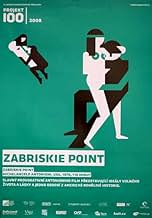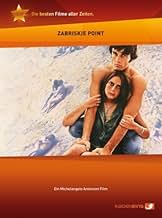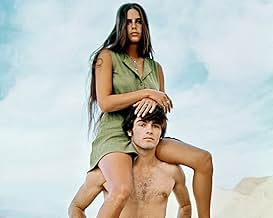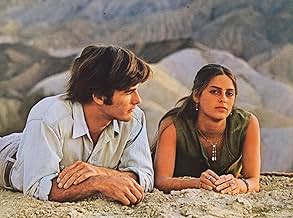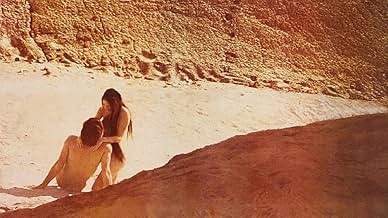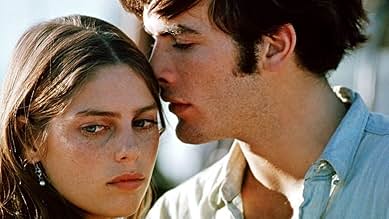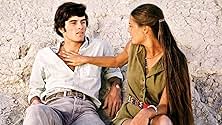Am Zabriskie Point, einer der tiefstgelegenen Stellen der Vereinigten Staaten, treffen sich zwei vollkommen Fremde: ein Student und eine junges Hippie-Mädchen, die eine hemmungslose Romanze ... Alles lesenAm Zabriskie Point, einer der tiefstgelegenen Stellen der Vereinigten Staaten, treffen sich zwei vollkommen Fremde: ein Student und eine junges Hippie-Mädchen, die eine hemmungslose Romanze beginnen und sich im Staub des Death Valley lieben.Am Zabriskie Point, einer der tiefstgelegenen Stellen der Vereinigten Staaten, treffen sich zwei vollkommen Fremde: ein Student und eine junges Hippie-Mädchen, die eine hemmungslose Romanze beginnen und sich im Staub des Death Valley lieben.
- Auszeichnungen
- 1 Gewinn & 1 Nominierung insgesamt
- Radical student
- (Nicht genannt)
- Police lieutenant on loudspeaker
- (Nicht genannt)
- Highway patrolman
- (Nicht genannt)
- Airport mechanic
- (Nicht genannt)
- University student
- (Nicht genannt)
- Arrested student
- (Nicht genannt)
- College student
- (Nicht genannt)
- Man in Deli
- (Nicht genannt)
- Gun store owner
- (Nicht genannt)
- …
- Departing Plane Passenger
- (Nicht genannt)
- Documentary cameraman
- (Nicht genannt)
Empfohlene Bewertungen
The subsequent burial by the studio is understandable, after such a whopping investment and dismal return. It is sad that people don't get to see this film any more as i believe Antonioni has been proved right. Here he predicts the end of the hippie/civil rights movement in the politics of America. Everyone is much more interested in what goes into their pockets and the relentless expansion of living space into the inhospitable (yet beautiful) desert and beyond. How i would love to see interest in this film re-kindled and a lavish DVD release.
I beseech people to watch Zabriskie Point with an open mind and an open heart. We have a genuinely unique film commenting on a turning point in the history of the most powerful nation on the planet, and we have forgotten about it.
An unexpected gem.
What he does lack is a point, at least the kind of point that he could bring in Blow-Up and The Eclipse. You get the feeling of what is around these characters, what the themes are bringing forth to their consciousness, however in this case the characters and the actors don't bring much conviction or purpose. Antonioni, coming from the school of hard-knocks, neo-realistic film-making, does do what he can with his mostly non-professional cast (those who look most like real actors are subjugated to the roles of the corporate characters), but the two stars Mark Frechette and Daria Halprin seem as if Antonioni's under-directing them. Perhaps that was the point. The story's split into three acts, thankfully not too confusing, as Mark escapes his existence around the boiling, dangerous campus life going on in the circa late 60's LA area, and Daria is sent out from LA to drive to Phoenix for some business meeting. They meet by chance as Mark's plane (how does he know how to drive, maybe a little background info there?) and Daria's car meet up, and they spend some time together in an existential kind of groove out in the desert. Aside from a stylistically mesmerizing if bizarre sex scene, much of this act isn't terribly interesting.
The two leads are fair enough to look at, but what exactly draws them to each other outside of curiosity? The ideas that come forth (in part from a screenplay co-written by Sam Shepard) aren't too revealing, except for one brief instant where drugs vs. reality is brought up. Then the film heads towards the third act, as Mark decides to do the right thing, under disastrous circumstances, and Daria arrives at her boss' place, only to be in full disillusionment (not taking into account the infamous last five minutes or so of the film). Although the film took its time telling its story, I didn't have as much of a problem with that as I did that the story only engages a certain kind of viewer. I understand and empathize with the feelings and doubts and fears as well as the self-confidence of the "anti-establishment", but maybe Antonioni isn't entirely fully aware of it himself. In some scenes he as director and editor (and the often astounding cinematography by Alfio Contini) find the scenery and backgrounds more enlightening and fixating than the people in the foreground. Not to say the technical side of Zabriskie Point isn't involving to a degree (this may make some feel drowsy, as Antonioni is probably far greater as a documentary filmmaker as he is a theatrical director like say Francis Ford Coppola is).
The deserts, skies, city, and even the faces in close-ups are filmed with the eye of a filmmaker in love with the art of getting things in the frame, bringing us in. The soundtrack is equally compelling, with a master stroke including a sweet Rolling Stones song at one point, and then a crushing, surreal Pink Floyd song (re-titled from 'Careful with that Axe Eugene, one of their best pre-Dark Side) in the explosion sequence. If only the performances weren't so one-sided I might find this to be on par with Blow-Up or The Eclipse. It's an unconventional stroke of genius on one hand, and on the other a boring take on what was the hippie/radical movement of the late 60's. But hey, what may be boring for an American such as myself born in the eighties may not be to others outside the US, such as say, Italy. And it does ask to not be discarded right away after one viewing.
The audience was held spellbound as the film unfolded its artisty on the huge panoramic screen. Watching this superb print, shown the way Antonioni intended, made one aware that this is indeed a modern art work. It was all the more fitting that the series is housed in the Cleveland Insititue of Art in University Circle.
Antonioni's compositions are created for the Cinemascope landscape. His beautiful balancing of images, striking use of colors, sweeping choreographic movements, all are the work of a genuine artist, using the screen as his canvas.
At last the audience could understand "Zabriskie Point." As its narrative unfolded, it became obvious that this work is not about story per se, but rather an artist's impressionistic rendering of fleeting images of his subject. The setting of some of the more turbulent activities of the sixties provides only a dramatic motor for the artist's sweeping collage.
Antonioni is not bound by conventional narrative standards, and can pause at any point to creatively embroider an event with grandiose embellishments. The audience willingly went with the flow of his remarkable imagination, as his huge images on the massive canvas held one in rapt attention. While the audience may have been only tangentially involved in character relationships, it realized the theme here is human aleination, the director's recurring theme.
It was also realized that no print any smaller or of lesser quality than this original one in Cinemascope can do justice to this particular rendering. The audience was therefore all the more appreciative of viewing "Zabriskie Point" in its original, breathtaking format, and broke into thunderous applause at the end.
Zabriskie Point starred two very appealing leads that should have become big stars of the 70s, but never did. Mark Frechette, whom I'd already seen in Francesco Rosi's fine WWI-set movie Uomini Contro, had a very tragic life and died aged just 27. According to his biography page, he donated his $60,000 earnings from Zabriskie to a commune. Mark's co-star Daria Halprin, apparently also Dennis Hopper's wife later on, has the stunning, natural beauty and appeal of a young Ornella Muti one of those luminous beauties that don't need a shred of make-up to turn heads. Like Frechette, she has only graced a couple of obscure movies and has never become a star, but at least she didn't die tragically. Most notably, Zabriskie Point contains one of the most original sex scenes ever filmed - one that brings home a sense of youthful playfulness like few I've seen - as well as a powerfully cathartic ending. It may be the most banal sequence ever filmed as far as its symbolism goes, but I can't see how anyone can deny its beauty and wonderful sense of emotional release. Never has an explosion looked so good, and so poetic. It seems to be an explosion that restores order rather than bringing chaos.
Poor old Mark Frechette and Daria Halpin as the star crossed lovers - definitely in the wrong place at the wrong time (weren't they EVERY wronged and downtrodden teenager of the period???) copped most of the flack, totally unreasonably. They were SUPPOSED to be Mr and Miss typical troubled youth, not Rhett Butler and Scarlett O'Hara on a bender! This was an image-driven film and many flag waving americans were incensed that Italy's outre director Antonioni was given free rein to portray the angst of American youth.
Cinematically, the film was awesome. In London at the time, I saw it on its release and thought that from an objective viewpoint it was quite brilliant (admittedly, I was only 24 myself). Many have commented on its alleged self-indulgence. Yeah, well it WAS Antonioni's film - surely he was free to express his art-form in whatever way he saw fit at the time? The desert scenes have not been topped by any film since.
ZABRISKIE POINT may be shy of "masterpiece" status (mind you, who amongst is solely qualified to make THAT call?) but it is probably now, THE defining film of 70's culture. A time when acid trips, communal living, even just plain old fashioned "love" were not that easy a choice to live with!
Wusstest du schon
- WissenswertesAntonioni met with Jim Morrison during early production to ask for a musical contribution to the soundtrack. Morrison and the Doors provided "L'America" which Antonioni then rejected.
- PatzerZabriskie Point, in Death Valley National Park (California, USA) is not actually the lowest-elevation point in the United States. That would be Badwater Basin, at a depth of 282 feet below sea level, which is also located in Death Valley National Park about 20 miles away.
- Zitate
[booking a protester]
Cop: Occupation?
William S. Polit, protester: Associate professor of history.
Cop: That's too long, Bill. I'll just put down clerk.
- Alternative VersionenIn the original version, the song that's playing when Daria drives away at the very end and over the closing "End" title card is a Roy Orbison song, but in the 1984 MGM/UA Home Video version it's a continuation of the Pink Floyd song. The 1991 MGM/UA Home Video version restores the Orbison song.
- VerbindungenEdited into Geschichte(n) des Kinos: La monnaie de l'absolu (1999)
Top-Auswahl
- How long is Zabriskie Point?Powered by Alexa
Details
Box Office
- Budget
- 7.000.000 $ (geschätzt)
- Weltweiter Bruttoertrag
- 84.879 $
- Laufzeit1 Stunde 53 Minuten
- Sound-Mix
- Seitenverhältnis
- 2.35 : 1
Zu dieser Seite beitragen



